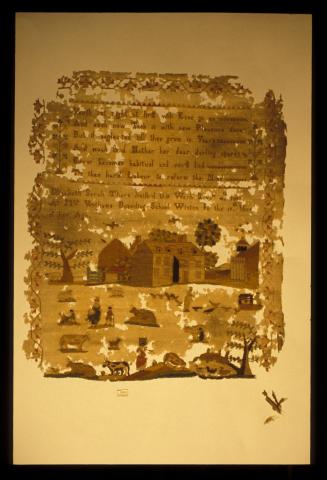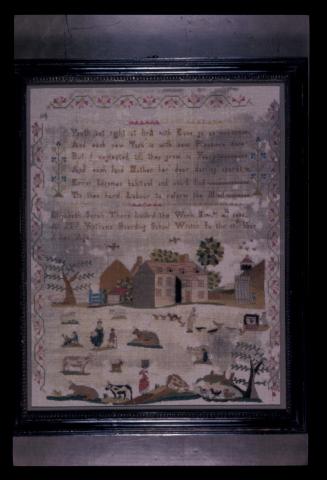Deterioration
The principal agents of deterioration of textiles are:
- light;
- temperature and relative humidity;
- pollutants and chemical degradation;
- dust;
- inappropriate repairs and handling; and
- biological deterioration (insects and mould)
Substances incorporated in finishing and manufacturing processes may contribute to textile degradation. For instance, metal-based dyes and dye mordants can accelerate rotting of fibres, producing gaping holes in affected fabrics. In silks the weighting, which was introduced in the form of metal salts to increase the weight and make the silk crisper and more drapable, actively promotes the degradation of the fabric. There is little that can be done for these fabrics as deterioration will continue even under good storage conditions.
Light
All forms of light are damaging to textiles. Photochemical reactions initiated by light energy can lead to the deterioration of the principally organic textile components. The damage to a textile by visible and invisible radiation is cumulative and irreversible. Of particular importance is the ultraviolet (UV) radiation band which supplies enough energy to break the molecular bonds found in textile fibres. UV radiation is present in daylight and is also emitted by many types of artificial light. Control of visible light and UV radiation is described in an earlier chapter (see the chapter Preventive Conservation: Agents of Decay).
Closely monitor and limit the amount of light to which textiles are exposed, particularly those on display. Storing textiles in the dark is standard practice.
Isolate light sources from textiles because heat generated from light sources can accelerate deterioration. Most light sources generate heat and this can build up, especially if the light source is housed in the same closed cabinet as the textile.
Temperature and Relative Humidity
Do not expose textiles to high temperatures. Often the effects of heat damage are not immediately obvious but may be manifested by fibres becoming brittle or discolouring.
Relative humidity is a well understood agent of destruction. Fibres expand and contract in line with changes in relative humidity. Continual fluctuations of this type create stresses in fibres which may eventually lead to fragmentation of the textile. Under low relative humidity conditions fibres shrink, textiles become desiccated and lose flexibility. They are then more susceptible to damage when handled. If on the other hand the textile is exposed to high relative humidity conditions then the chemical stability of the textile will be threatened, the effects of light exposure enhanced and mould growth and insect attack encouraged.
Pollutants and Chemical Degradation
As in the case of heat damage, many of the effects of chemical reactions occurring in textiles are not immediately obvious. They often only become evident after physical damage to the fabric has already occurred. The effects of chemical degradation are irreversible.
Air pollutants such as sulphur dioxide, oxides of nitrogen and ozone all contribute to the chemical degradation of textile materials. These pollutants are more likely to cause problems in towns and industrial areas where emissions from car exhausts and factories are the greatest.
Although cellulose fibres, such as cottons and linens, can tolerate a limited degree of alkalinity, they are sensitive to acidic and strongly alkaline conditions. Both acids and strong alkalis attack the molecular structures in the fibres, causing them to become friable and the textile to weaken.
Protein fibres, such as wool and silk, can tolerate exposure to weak acidic conditions but are susceptible to attack by alkalis and strong acids. These latter substances attack the molecular structure, degrading the fibres and robbing them of tensile strength.
It is important to take these chemical reactions into account when designing treatments for textiles. For example, the type of cleaning processes applied to a fabric must be thought through carefully so that damage to the textile is avoided. For instance, do not use alkaline cleaning agents on protein-based textiles.
Dust
Dirt and dust inevitably end up embedded in textile fibres. Dust particles can cause physical damage through the abrasion of fibres, or promote degradation by acting as a nucleus for condensation, mould formation and accelerated chemical attack by adsorbed chemicals.
An indirect effect of dust and dirt build-up on textiles is the impact of resultant cleaning on these materials. All cleaning treatments are irreversible and no matter how carefully they are carried out, have the potential to weaken textiles.
Inappropriate Repairs and Handling
Much damage is done to heritage textiles by inappropriate repairs, wearing of costumes and handling textiles incorrectly. Well meaning custodians of textile collections have been known to smarten up, add to and/or replace parts of textile artefacts in their effort to care for their textiles. Minimal intervention is recommended.
The wearing of heritage costumes is considered inappropriate for many reasons. These reasons include stressing an already fragile material, the use of unsupportive under garments for the style of the costume, unnecessarily introducing pollutants, including perspiration, into the textile, possible staining from food and drink, hems trailing and possibly exposure to extreme light levels.
Inappropriate handling will transfer oils, dirt and acidity from hands to textiles and textiles can be damaged if not well supported while being moved or manipulated.
Biological Deterioration – Insects and Mould
Textiles made from naturally occurring materials are most susceptible to insect attack whereas synthetic materials are rarely damaged (Figure 2). Insects cause damage in two main ways. Insect larvae destroy fibres by eating them while soiling and disfiguration occur when insect faeces and frass accumulate on textile materials.
The presence of moths flying about is only indicative of a potential problem as it is the larvae that emerge from the eggs laid by the moths that cause problems for textile collections. Micro-organisms flourish when air circulation is low and the relative humidity is 70 % or more and are capable of rapidly breaking down and drastically weakening textiles. Mould or mildew can result in stains on the textile that are often very difficult, if not impossible, to remove.
Figure 2: (a) Sampler before treatment. Damaged by insects, neglect and poor storage.
(b) Sampler after treatment – supported on a linen backing and framed.
Of the naturally occurring textiles, protein-based materials (wool, silk and fur) are most vulnerable to insect attack (especially by carpet beetles and clothes moths) whereas cotton and other cellulose-based materials are more prone to microbiological attack. Under conditions that favour mildew growth however, wool will still be attacked. Similarly cotton and other cellulose-based fibres are still at risk from attack by insects such as silverfish. Damage may also be caused to textiles by wood-boring insects that penetrate textiles that are in contact with their preferred food source.














